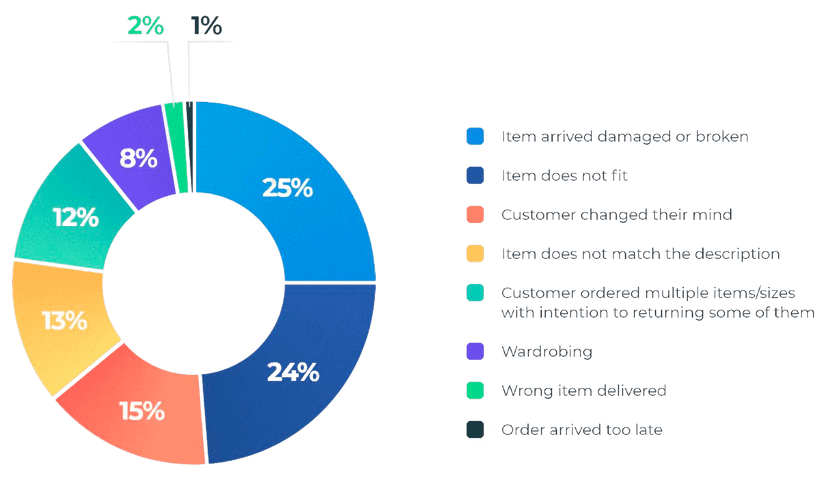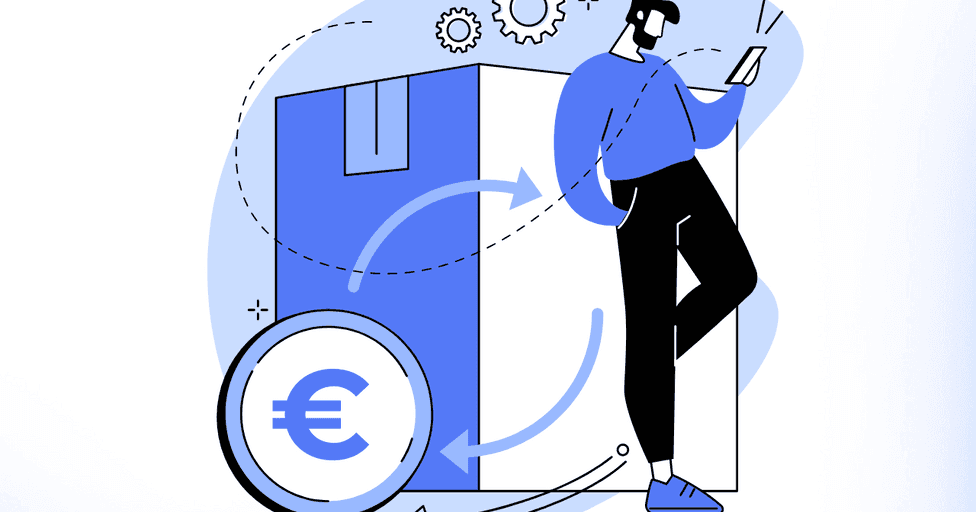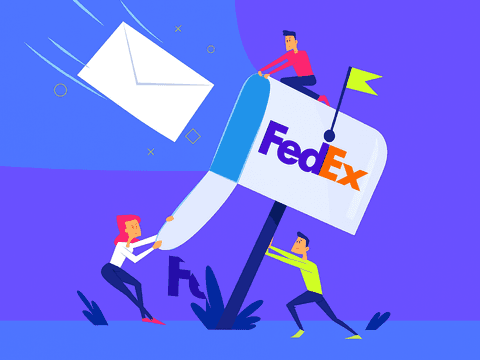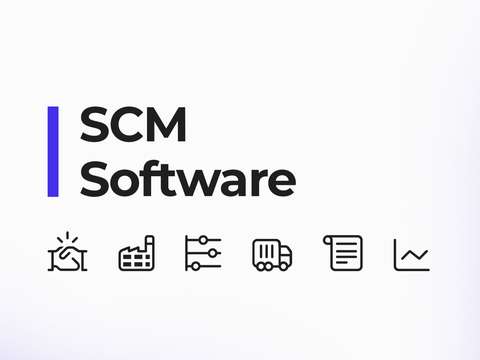Numerous reasons can lead customers to request product returns or refunds. Identifying and addressing the most common causes of returns is crucial for reducing associated costs and improving business profitability.
Leveraging tools like enterprise returns management software can make this process more efficient by providing actionable insights, automating workflows, and streamlining operations.
To this end, we have compiled a list of the most significant reasons that drive customer returns. By recognizing and proactively addressing these issues, businesses can effectively manage returns, enhance customer satisfaction, and boost revenue.
Why return reasons matter in retail?
In the realm of business, customer feedback is a treasure trove of valuable insights, especially when gleaned at pivotal moments when customers are predisposed to share their candid opinions. Return reasons, often relegated to the realm of mere logistical details, harbor immense worth as a window into customer sentiment and the underlying causes of dissatisfaction with products or services.
By plumbing the depths of return reasons, businesses can unlock a veritable treasure trove of information that can fuel strategic decision-making, optimize operations, and elevate customer satisfaction.
Most common return reasons in eCommerce
Return rates exhibit considerable diversity depending on the industry, retailer, and product categories involved. These rates can range from a high of 30% for clothing and apparel to as low as 1-2% for books and pharmaceuticals.
The reasons behind returns also vary across product types, but in broad terms, statistical evidence indicates that, among every 100 returns, the primary causes can be categorized into the following eight common factors.

How to handle each type of return
Apply the following tips when your customer wants to return a product and lower your refund costs:
1. Item arrived damaged or broken
Damaged products are the most common reasons for returns, and it's understandable why. While damage is often caused by couriers, there is till things every eCommerce can do, to reduce this type of returns and to lower costs associated with them:
- Use high-quality packaging materials: This includes sturdy cardboard boxes, bubble wrap, foam inserts, and other protective materials
- Pack items carefully: Make sure to fill any empty space in the box with cushioning material and to wrap fragile items individually
- Label fragile items clearly: Use "Fragile" labels and other markings to alert the courier that the package contains delicate items
- Choose a reputable shipping carrier: Do your research to find a carrier with a good track record of delivering packages safely and on time
- Invest in tracking and monitoring: Implement advanced tracking systems to monitor the journey of packages in real-time to proactively intervene in case of delays
2. Item doesn't fit
Returns due to fit issues may appear subjective, tied to somehow mysterious preferences of the individual shoppers, however, such complaints often signal underlying issues with the online shop´s user experience and content. This is how you can reduce these kind of returns to a minimum:
- Provide comprehensive size charts: This will help to guide customers in selecting the right fit
- Offer clear and concise sizing information: Make sure to place it visibly in product descriptions. This should include information on the type of fit, the fabric, and how the product is measured
- Use fit models in your product photos: This will give customers a better idea of how the product will look and fit on a real person. Even just by mentioning what size a model is wearing can give a good idea to the shopper of the items fit
- Encourage customers to leave fit-related reviews: Enable uploading photos to assist others in their purchasing decisions
- Implement virtual try-on or augmented reality tools: This helps customers visualize how items will fit
- Offer personalized size recommendations: Use data based on customers' body measurements and previous purchases to do this
3. Changed their mind or buyer remorse
We all change our mind sometimes, and it is easy to get caught up in shopping online, only to release later on when you have bought something you really don't need. Even though online retailers love spontaneous purchases, it is good to minimize potential buyers remorse to lower returns related costs and losses:
- Ensure an excellent post-purchase experience: Keeping them engaged, informed and happy after the sale has been made. Personalized and seamless post-purchase customer communication can help customers confirm their purchase decision was the right one
- Never run potentially misleading offers or promotions: These guarantee disproportionate returns
- Use data to understand customer behavior: This can help you identify products that are more likely to be returned and take steps to reduce returns
- Personalize the shopping experience: This can help customers find products that they are more likely to love and keep
- Display user-generated reviews and ratings: Provide insights from other customers and build confidence in purchasing decisions
- Offer responsive customer support: Through chat, email, or phone to assist customers in selecting the right product and addressing any pre-purchase questions or concerns
- Provide clear and concise product descriptions and images: This will help customers make informed purchasing decisions
4. Item does not match the description
When products fall short of customer expectations, it not only results in returns but can also lead to losing valuable customers. Trust is fragile, and disappointment can drive customers away, impacting both sales and reputation. Make sure this does not happen by:
- Use a product information management (PIM) system: A PIM system can help you ensure that your product descriptions are consistent and accurate across all of your sales channels
- Write clear, concise, and accurate product descriptions: Include all of the relevant information that customers need to make an informed purchase decision, such as the product's features, specifications, and dimensions
- A/B test product descriptions: This will help to identify and correct any errors and see what works best
- Use artificial intelligence (AI) to help you write and improve your product descriptions: AI can help you to ensure that your descriptions are accurate, complete, and engaging
- Proofread your product descriptions carefully before publishing them: Make sure that there are no errors in grammar, spelling, or punctuation
- Use high-quality images that accurately represent the product: Include multiple images from different angles to give customers a good idea of what the product looks like
- Use customer feedback to improve your product descriptions: Pay attention to customer reviews and comments to see where you can improve your descriptions to be more accurate and informative
- Offer real-time chat support or helplines: When customers have specific questions about products, knowledgeable staff can clarify doubts, ensuring customers have accurate information before making a purchase
5. Customer ordered multiple items/sizes with intention to returning some of them
Unlike returns due to bad fir, there returns are guaranteed to happen already before the finalize their initial order. This is because they are purposely ordering more variants of the same product, only because they are not sure of the fit or like of the item. Here are some extra ways you can deter this kind of shipping habits in addition to what has been mentioned above:
- Advertise easy exchanges before purchase: Make sure your customers know that the exchange process is easy and automated, so they do no order multiple sizes right away
- Charge return fees for unnecessary returns: This additional cost will discourage this type of returns
- Educate customers on return impact via shop UI: Remind your customers that returns increase carbon emissions and waste
- Analyze return patterns: This enables you to identify potential culprits and implement stricter policies. You can also target these customers with educational materials about the environmental impact of returns or to offer them special discounts on free returns
6. Wardrobing (intentional return after single use)
Wardrobing is the act of buying items with the intention of using them briefly and then returning them after just one use. This behavior is considered a mild form of purchase fraud and customers who engage in these kind of actions are not the kind of customers online shops should want to keep, so some drastic measures are completely justified:
- Prevent abusive returns: Configure your returns UI to automatically reject the types of returns that you classify as wardrobing
- Use tamper-proof tags: Tamper-proof tags are difficult to remove without damaging them. This makes it difficult for customers to wear clothes and then return them as new
- Inspect returned items carefully: Check for signs of wear, such as wrinkles, deodorant stains, or pet hair. If you find any signs of wear, you can refuse to acceptthe return
- Ask for photos of items to be returned: This will help to identify items that have been worn or damaged before they are returned
- Have a clear return policy that does not allow wardrobing practices: Be clear with wording to state that items must be returned in new condition, with all original tags attached
- Educate customers about wardrobing: Explain in newsletters and blog posts that wardrobing is a form of fraud and that it can have negative consequences for other customers.
- Utilize technology to prevent wardrobing: Monitor customer return histories and flag potential wardrobing behavior
7. Wrong item delivered
Consumers have every right to be frustrated when a retailer makes a mistake during order fulfillment. This will not only lead to accumulating returns costs but also losing customer trust. There kind of errores are easy to avoid completely and there should be no excuse not to follow these simple steps:
- Utilize shipping automation software: This will help you reduce these type of incidents to 0
- Use a barcode tracking system: Track orders throughout the fulfillment process and remove human error in order compilation.
- Double-check orders before shipping them: This should be done by a separate employee than the one who picked the order.
- Use clear and concise product labels: This will help to reduce the risk of errors occurring when picking orders
- Quality check returned items: This will help to identify and address any systemic issues that are causing wrong orders to be shipped.
- Simplify wrong order returns for customers: Offer free returns for wrongful deliveries and make it easy for customers to start a return online
8. Order arrived too late
For customers, delivery speed can be a deciding factor between shopping with you or a competitor, so its essential to meet their expectations:
- Set realistic delivery expectation: Be honest with customers about how long it will take for their order to arrive
- Partner with reliable shipping carriers: Choose shipping carriers that have a good track record of delivering packages on time
- Track shipments carefully: Monitor shipments closely and intervene if there are any problems
- Communicate with customers about delays: If there is a delay in shipping, notify customers as soon as possible and offer them updates.
- Offer flexible return policies: Give customers the option to return or cancel their order if it is delivered late
- Utilize tech for efficient shipping automation: Ensuring orders get sent out faster with the right courier
Recommend to read
Unlock latest strategies and insights about return management by reading our comprehensive guide.
Analyzing return reasons for business growth
Analysis of reasons for return can give a lot of valuable data for optimizing business processes and improving customer experience. We in Outvio are keen on numbers and we believe that there is no better source of inspiration than close look at analytic reports. We encourage online stores to collect and analyze as much data as possible to better understand what sort of problems users may have and how you can solve them.
Improving advertising quality
Many online stores run ads across the web to attract new users and promote specific products. Typically, a good measure of advertising success is ensuring that every dollar spent on ads generates at least three dollars in income. For instance, if the average conversion cost is $22, clients should aim to spend at least $66 to maintain profitability.
However, a common oversight is failing to account for returns, which directly impact the profitability of advertising channels. We recommend that online stores incorporate an additional event in their analytics to track the number of returns in their ad manager. This provides a comprehensive understanding of which channels and types of ads yield the most conversions and the fewest returns.
In practice, it's possible that an ad generating 70 purchases daily may seem successful, but if 25 of those purchases are returned, its profitability could be much lower than an ad resulting in 50 conversions with 5 returns. Online stores often incur costs for shipping and handle the reverse logistics of returned products. In the first scenario, the online store shipped 50 parcels for free and invested additional funds to attract 25 orders, resulting in zero profits.
Enhancing user experience
Another factor that can assist managers in improving their eCommerce performance is conducting a detailed analysis of return reasons for different product types. For example, identifying the top three most returned products can provide valuable insights for enhancing the user experience. To conduct a more precise analysis, it's essential to evaluate each product individually rather than analyzing all products collectively.
Start by examining one product category and identify the most common reason for returns associated with that specific product. For instance, if sizing issues are prevalent, making minor adjustments to the product description or incorporating a warning message on the product page can greatly assist customers. In cases where orders frequently arrive damaged, it signals the need to consider special packaging for that product type or reevaluate the delivery method.
Handling returns due to a change of mind by customers can be challenging. However, conducting additional analysis can help identify patterns. If the same customer frequently cites this reason for returns, it may indicate potential return fraud. Moreover, if customers frequently change their minds about a particular product, it could suggest that they found a similar, cheaper alternative on your website. Therefore, examining purchasing patterns and subsequent sales after a return can offer valuable insights. Although your online store may offer similar products, differences in price and quality could influence customer decisions.
Automating workflow based on return reason
Big e-commerce platforms that handle over 25,000 shipments and 3,000 returns per month may encounter this issue most frequently. Even with the use of return management solution to automate traditional return processes, developing infrastructure capable of addressing every return reason individually can be challenging.
At Outvio, we prioritize attention to the details that matter most to businesses. We have implemented return rules and various return workflows tailored to specific return reasons. For example, if a client returns a product due to sizing issues, our system can offer an exchange instead of a refund. If a product is damaged, the system can prompt the client to provide pictures for evaluation before proceeding. In some cases, it may be more cost-effective to simply send a new product rather than requiring the client to arrange a return shipment.
Furthermore, you can streamline processes by optimizing reverse shipping. For instance, damaged products can be automatically routed back to the producer, while products with sizing issues can be returned to your warehouse for reconditioning.
Return reasons list: Comparison table
| Category | Reason for Return | Impact on Business | Strategy to Reduce Returns |
|---|---|---|---|
| Product Issues | Defective or damaged product | Increases replacement and logistics costs | Improve quality control and secure packaging |
| Order Errors | Incorrect item sent | Reduces customer trust | Optimize picking and packing processes |
| Unmet Expectations | Product different from description | Affects store reputation | Provide detailed descriptions and accurate photos |
| Sizing/Fit Issues | Incorrect size or fit | Increases return rates in fashion | Interactive size guides and personalized recommendations |
| Change of Mind | Customer no longer wants the product | Generates unnecessary costs | Flexible but controlled return policies |
| Late Delivery | Product arrived too late | Reduces customer satisfaction | Optimize logistics and provide clear delivery times |
| Quality Problems | Poor material or craftsmanship | Decreases repurchase rate | Evaluate suppliers and perform quality testing |
| Compatibility/Functionality | Doesn’t work with other products | Increases customer frustration | Detailed technical descriptions and pre-sale support |
Conclusion
In conclusion, understanding the reasons behind customer returns is essential for businesses to effectively manage returns, enhance customer satisfaction, and ultimately boost revenue. By identifying and proactively addressing common return factors, such as damaged items, sizing issues, buyer remorse, or mismatches with product descriptions, businesses can mitigate return costs and improve overall performance.
Return reasons offer valuable insights into customer sentiment and satisfaction levels, enabling businesses to make informed decisions, optimize operations, and elevate the shopping experience. By implementing strategies tailored to address each type of return, from enhancing packaging practices to providing comprehensive size charts or leveraging technology to prevent fraudulent behaviors, businesses can minimize return rates and foster long-term customer loyalty.
Ultimately, by prioritizing customer satisfaction and investing in proactive measures to handle returns effectively, businesses can not only reduce costs associated with returns but also enhance their reputation, strengthen customer relationships, and drive sustainable growth in the competitive eCommerce landscape.




